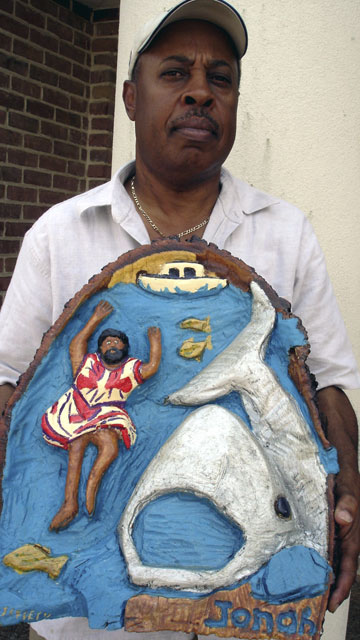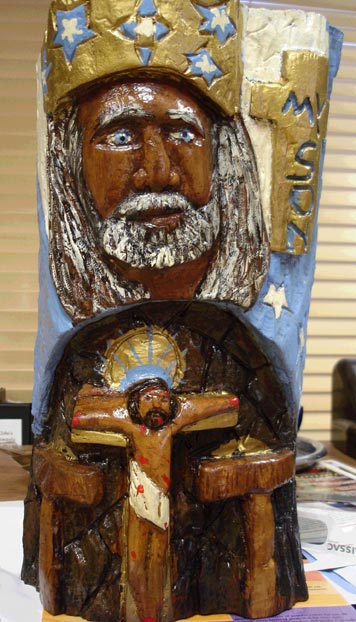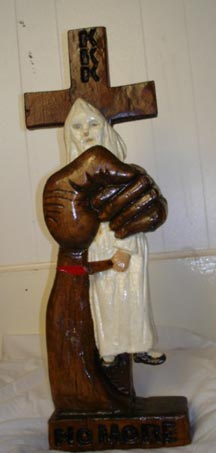
Columbus, Ohio USA
Visit Homepage www.shortnorth.comCarving Out a New Niche
Memphis firefighter-turned-woodcarver Edwin Jeffery Jr.
launches his first solo show at the Lindsay Gallery
July 2005
by Jennifer HambrickReturn to Features Index
© PHOTOS COURTESY OF LINDSAY GALLERY, COLUMBUS, OH
Edwin Jeffery Jr. with Jonah A piece of wood, a chisel or two and some acrylic paint.
You’d never know from such humble equipment that Memphis woodcarver Edwin Jeffery Jr. is one of America’s most promising self-taught artists. But that’s just what some art collectors and gallery owners across the country are saying.
“He’s the most interesting thing we’ve found in a while,” says Duff Lindsay, owner of Columbus’ Lindsay Gallery. “I’ve seen a lot of work around the country and he’s the real thing.”
The Lindsay Gallery, 986 N. High Street, will display Jeffery’s work in “Memphis Soul: The Carvings of Edwin Jeffery” July 8 through August 27. The exhibit is the first full-scale gallery showing of Jeffery’s work outside of Memphis and will commence with an opening reception on July 8 from 6 to 9 p.m. featuring live soul music by D. J. Pete.
There is a quadrivium of great self-taught American folk artists that includes Mississippi native and Columbus transplant Elijah Pierce – generally regarded as the best – Leroy Almon, who apprenticed with Pierce, Josephus Farmer and New Orleans carver Herbert Singleton. Many folk art experts regard Singleton as the best self-taught carver alive today. Shari Cavin, owner of New York’s Cavin Morris Gallery and a specialist in the art of self-taught artists, believes Jeffery’s work can compete with the best.
“I think that he could easily take his place along with other woodcarvers of his generation, including Herbert Singleton and (Leroy Almon),” Cavin said.
And like Singleton, Almon and Pierce, Jeffery came to carving late in life as a second career.Fire and Wood
Jeffery, 56, was born in Memphis in 1949. His experience as an African-American in segregated Memphis would come to play a role in the artwork of his later life.
“It was kind of tough,” Jeffery said. “They just integrated the schools in Memphis when I went to high school. When I got on the fire department there were only about 39 blacks in Memphis in the fire department.”
Although Jeffery’s father was a carpenter, Jeffery didn’t learn the craft of woodworking at home.
“My father never pressured me and my brothers to turn to carpentry,” Jeffery said. “He’d teach us if we wanted to learn, but if we didn’t want to learn, he told us to get out of the way because he didn’t have time for foolishness. So I got out of his way.”
Instead, the young Jeffery turned his hand to schoolwork and artistic pursuits, winning drawing and painting contests in junior high and high school. “I could draw and paint, but I didn’t know I had any woodcarving talent.”
Jeffery finished high school, dropped out of college, and in 1973 joined the Memphis Fire Department, devoting 28 years to salvaging things (like wood) that burn and retiring in 2001 at the rank of Lieutenant. He thinks things might have turned out differently if he had learned carpentry from his father.
“I believe that I might have gone another route,” Jeffery said. “I might have been a carpenter, not a firefighter.”
And, as it happens, if it weren’t for another firefighter’s passion for guns, the thought of making art from wood might never have entered Jeffery’s mind.
“Someone brought a book on hand-carved gun stocks to the fire station one day,” Jeffery said. “It (the art of woodcarving) looked like it was something simple that didn’t require too much and I said, ‘Hell, I’d like to do that.’ So I went to the library and got some books and I got some tools and I found out I had a talent for it.”
When he and the other firefighters weren’t on call, Jeffery honed his craft at the fire station with a set of chisels and a wooden mallet on whatever wood was available.
His first piece is a case knife carved from a thin 8-by-12-inch block of pine.
“I’ve had it for 29 years. I’ve been offered money for it, but I don’t want to sell it,” Jeffery said.
My Son Jeffery’s output of carvings was slow to accumulate during his firefighting years. What pieces he did produce he gave away to friends, family members and, Jeffery says, to people who were just plain nice.
“I used to carve a piece and give it to a person just because I liked them,” Jeffery said. “I’ve given so many pieces out to so many people, it’s a crying shame.”
Some of these pieces are the tiny red-painted roses like the ones Jeffery carved for each of his five sisters. Others are pieces like the carving honoring a Lieutenant firefighter killed in the line of duty. Jeffery donated this piece to the Memphis Fire Academy, where it is still on display. Jeffery also has donated pieces to other prominent Memphis institutions, including the National Civil Rights Museum, the Center for Southern Folklore and St. Jude’s Hospital.
After almost thirty years of carving, Jeffery still works only with manual tools instead of power tools and revels in the tactile experience of finishing his pieces.
“I don’t even have a sander,” Jeffery said, “I hand sand. I like to feel the contour of the wood in my hand and know that I’m doing it right.”Spreading Like Wildfire
Although Memphis-area art galleries, including D’Edge Arts and Unique Treasures and the Painted Planet Artspace, had displayed some of Jeffery’s carvings, recent attention from two Memphis art collectors has taken Jeffery’s work beyond the Memphis city limits.
Craig Weiner, a market strategist by profession, began collecting folk and outsider art more than a decade ago. He was introduced to Jeffery’s work in 1995, when he saw a photograph of one of Jeffery’s pieces in the local newspaper. Weiner visited the owner of the piece at his gallery, where the work was on display. Weiner bought all 200-some pieces in the gallery that day, including four of Jeffery’s carvings. One of these pieces was Jeffery’s first of two carvings called City Boss. The carving depicts the current African-American mayor of Memphis, Willie W. Herenton, holding up the city of Memphis.
In 2004, John Jerit, folk art collector and owner of the Bartlett, Tennessee-based 3-D glasses manufacturer American Paper Optics, read a newspaper article about Weiner and his folk art collection. Jerit contacted Weiner, who invited him to view the collection. Jeffery’s pieces stood out.
“When I saw them, I was just knocked out by them,” Jerit said.
He tracked Jeffery down and bought two pieces directly from him. One of these pieces, The Rapture, shows a dark-hued arm reaching down from the clouds and drawing a woman heavenwards by the ankles.
Jerit took pictures of Jeffery’s pieces and sent them to folk art collectors and gallery owners – including Lindsay – around the country. Lindsay was inspired to begin making plans to bring Jeffery’s work, including his Rapture, to Columbus.
KKK No More Fire and Brimstone
What moved Jerit and Lindsay to invest in Jeffery’s career were the boldness of Jeffery’s subjects and the raw honesty of how he draws them out of the wood. Although Jeffery has carved likenesses of celebrities such as Oprah Winfrey, B. B. King and the late Ray Charles, many of his pieces, like Rapture, are dramatic representations of Christian subjects. Racial tension is another recurring theme in Jeffery’s work and is the central subject of a series of carvings depicting the Ku Klux Klan in violent scenes with blacks.
Years with little success in selling his Klan pieces to collectors or organizations taught Jeffery that there isn’t a large market for them. But he doesn’t carve these subjects to make money. He uses the wood to absorb his reactions to events in the world around him.
“All of my work tells a story,” Jeffery said. “Some days I feel a certain way and it shows up in my carvings. When (racially charged) stuff comes on the news, I start doing Ku Klux Klan things. Or when I start feeling religious, I do something religious. I have to get out what I feel. This is the way I speak without opening my mouth and making a fool of myself. I put it into wood.”
The honesty of Jeffery’s work speaks for itself. For Shari Cavin, Jeffery’s open confrontation of issues of racial prejudice and religion give his carvings a dimension of authenticity.
“I like the issues that he deals with very much because I think they’re honest,” Cavin said. “If he were dealing with issues that didn’t touch his life, I would wonder why he was doing it.”
“The thing about Jeffery,” Jerit said, “is that you can tell his work comes from the heart. Some of the first pieces I bought from him were KKK pieces. I really think he was about to cry when I bought them, but no one would touch them. I just knew I had to have them.”
When Weiner saw a large group of Jeffery’s pieces at a Memphis arts festival, he was moved by the mixture of controversial pieces and more mundane carvings of famous sports and entertainment
figures.
“There were some normal pieces, but there was a plethora of controversial stuff,” Weiner said. He bought one of Jeffery’s controversial pieces at this festival, a carving depicting Al Jolson in blackface on one side and a black man in whiteface on the other.
“To me,” Weiner said, “it’s even more interesting coming from an older black man who’s lived through everything and seen everything.”
Although Weiner gave the Al Jolson piece to his father, there is one piece by Jeffery in his 600-piece art collection that he says he will never relinquish: a carving of a Ku Klux Klansman in a white robe with the Klan’s initials on the sleeve. The catch? The Klansman is black.
“I like utter controversy,” Weiner said. “When I see all-out, full-blown controversy, I’m all over it. This theme (racial tension) keeps coming up in what he does, and it’s interesting to see this very sweet person come up with these controversial pieces. It’s as though he’s willing to accept the way society has been, but feels the need to express the fact that he hasn’t forgotten about all that stuff.”
Judy Peiser, executive producer with the Center for Southern Folklife in Memphis, also applauds Jeffery for confronting controversial issues in his carvings.
“I give him a lot of credit for doing things that make people squirm,” Peiser said. “I think it makes people ask questions, like ‘Why did this guy do this? Why do we still need to talk about this?’”
The Center for Southern Folklife displayed Jeffery’s carving KKK No More, in which a single black hand squeezes a hooded Klansman and a cross. Jerit’s visceral reaction to this piece led him to buy it and two other Ku Klux Klan carvings directly from Jeffery. In one of these pieces, Cross the Line, a Klansman holds a black man in one hand and a white woman and mulatto child in the other.
“It’s flat-out scary,” Jerit said.
Jeffery’s religious works also bring forth visceral reactions, even from his family. “I did a carving of the devil,” Jeffery said, “and my wife was too scared to let it in the house.”
In addition to Rapture, the Lindsay Gallery’s show will feature, among other pieces, Jeffery’s Trinity, in which a caucasian Jesus is carved in relief below a dark-skinned God in front of a sky blue field of acrylic paint. My Son shows the crucified Christ on Golgotha below the head of God gazing poignantly outward.
In the end, Jeffery says his family – not the need for self-expression and certainly not profit – is his most powerful motivation.
“I carve,” Jeffery said, “because I want to make a name and leave a legacy for my family. I don’t really care about the money. I want to leave something that says ‘I lived here.’ That’s why I do controversial pieces. They bring attention. I’m trying to leave a name to make my family proud.”
And Jerit predicts that people will soon know the name Edwin Jeffery Jr.
“I think in the long run that Edwin’s going to become a major carver in the self-taught world,” Jerit said. “In 18 months’ time, people will know who Edwin is.”©2005 Short North Gazette, Columbus, Ohio. All rights reserved.


